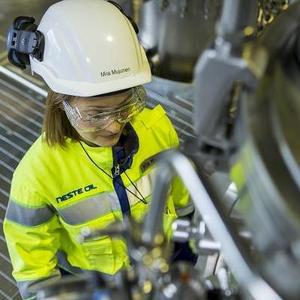Neste Oil to move away from microbial oil R&D

Photo: Neste Oil
October 7, 2014
BY Ron Kotrba
Neste Oil announced the company is realigning its long-term R&D efforts from microbial oil research to other areas of technology using forestry and agricultural waste. The company says it remains committed to its goal of further extending its feedstock base and making greater use of waste and residues in this particular area.
“Our microbial oil pilot plant at Porvoo has demonstrated that we have the technical capability for producing microbial oil,” said Neste Oil’s Senior Vice President of Technology Lars Peter Lindfors. “Seen in terms of sustainability, using waste and sidestreams generated by agriculture and forestry as well as industry has a very important role to play in the future, and we have successfully used straw, for example, to produce microbial oil. Two years of in-depth microbial oil research at the pilot plant has generated a lot of valuable know-how and extended our patent portfolio, and we will be able to use the results of this work in other research projects.”
Advertisement
Despite the knowledge gained from Neste Oil’s microbial oil work, however, Lindfors said the process is not economically competitive yet. “The time is not yet ripe for a commercial-scale microbial oil plant,” he said. “Lignocellulose material is not a financially competitive industrial feedstock for producing renewable diesel using the microbial oil process at the moment. We will continue researching agricultural and forestry waste and residues, and believe that lignocellulose inputs will play an important role in future renewable applications.”
Advertisement
Related Stories
The USDA significantly increased its estimate for 2025-’26 soybean oil use in biofuel production in its latest World Agricultural Supply and Demand Estimates report, released July 11. The outlook for soybean production was revised down.
U.S. fuel ethanol capacity fell slightly in April, while biodiesel and renewable diesel capacity held steady, according to data released by the U.S. EIA on June 30. Feedstock consumption was down when compared to the previous month.
The U.S. EPA on July 8 hosted virtual public hearing to gather input on the agency’s recently released proposed rule to set 2026 and 2027 RFS RVOs. Members of the biofuel industry were among those to offer testimony during the event.
The USDA’s Risk Management Agency is implementing multiple changes to the Camelina pilot insurance program for the 2026 and succeeding crop years. The changes will expand coverage options and provide greater flexibility for producers.
The USDA’s National Agricultural Statistics Service on June 30 released its annual Acreage report, estimating that 83.4 million acres of soybeans have been planted in the U.S. this year, down 4% when compared to 2024.
Upcoming Events










